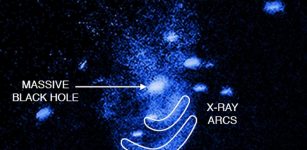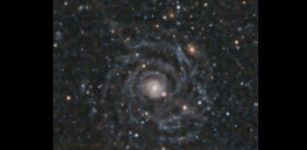Galaxies As “Cosmic Cauldrons” – Observations Of NGC 300 Spiral Galaxy
Eddie Gonzales Jr. – MessageToEagle.com – A team of researchers led by astrophysicist Dr Diederik Kruijssen from Heidelberg University, has now managed for the first time to reconstruct the time-evolution of molecular clouds and the star formation process within them.
Based on new observations of the NGC 300 spiral galaxy, researchers say these clouds are short-lived structures undergoing rapid lifecycles, driven by the intense radiation from the new-born stars.
Colour-composite image of the nearby spiral galaxy NGC 300 and the surrounding sky field, obtained in 1999 and 2000 with the Wide-Field Imager (WFI) on the MPG/ESO 2.2-m telescope at the La Silla Observatory. ID: phot-18a-02 Press Photo: 18/02 Object: NGC 300 Telescope: 2.2m Instrument: WFI Size: 4000×3722 Credit: ESO
Star formation within interstellar clouds of gas and dust, so-called molecular clouds, proceeds very rapidly yet highly “inefficiently”. Most of the gas is dispersed by stellar radiation, revealing galaxies to be highly dynamic systems, like “cosmic cauldrons”, consisting of components that constantly change their appearance.
The observed intensity of star formation in the NGC 300 spiral galaxy can be explained in two ways. Molecular clouds may be very long-lived and eventually convert all of their mass into stars. In this case, the positions of young stars should generally match those of the molecular clouds from which they formed.
Alternatively, stars may form very rapidly within molecular clouds and disperse the gas with their intense radiation, causing only a small fraction of the gas to be converted into stars. In this case, young stars and molecular clouds should generally reside in different locations.
Dr Kruijssen and his team combined two different sets of observations of the NGC 300 galaxy, which is about six million light years away from the Milky Way.
The first observation is a map of light emitted by carbon monoxide which shows where molecular clouds reside. The second is a map of hot, ionised hydrogen which marks the positions of massive, newly formed stars. These maps were obtained using the Atacama Large Millimeter Array (ALMA) of the European Southern Observatory (ESO) and the 2.2-meter telescope of the Max Planck Society and ESO.
Using a new statistical method which determines how molecular gas and star formation in galaxies are related on different spatial scales, they determined that the positions of molecular clouds and young, massive stars rarely coincide. Their conclusion is that stars form very rapidly, such that gas and young stars represent distinct, subsequent phases in the lifecycle of molecular clouds.
“Our findings demonstrate that star formation proceeds very rapidly and highly inefficiently,” explains Dr Kruijssen, research group leader at the Institute for Astronomical Computing, said in a press release.
“Molecular clouds in NGC 300 live for about ten million years and take only about 1.5 million years to be destroyed, well before the most massive stars have reached the end of their lives and explode as supernovae.”
“We will now proceed to investigate the relation between molecular clouds and young stars in galaxies throughout the cosmos. In the near future, this will allow us to understand galaxies as collections of components that undergo star formation-driven lifecycles and together shape the appearance of their host galaxies,” explains Dr Kruijssen.
Written by Eddie Gonzales Jr. – MessageToEagle.com Staff Writer











